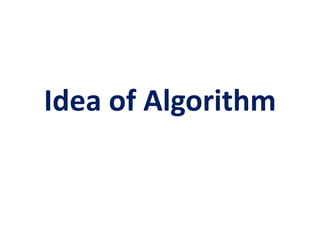4. algorithm
•
1 j'aime•737 vues
c_programming, Introduction to C,computer, algorithm
Signaler
Partager
Signaler
Partager
Télécharger pour lire hors ligne

Recommandé
In this presentation slides you will able to understand easily ,this slides contain loops of c++ programming language which contain for loop , while loop , do while loop and nested these all are describe with definition,examples and flow charts Loops in c++ programming language 

Loops in c++ programming language MUHAMMAD ALI student of IT at karakoram International university gilgit baltistan
Recommandé
In this presentation slides you will able to understand easily ,this slides contain loops of c++ programming language which contain for loop , while loop , do while loop and nested these all are describe with definition,examples and flow charts Loops in c++ programming language 

Loops in c++ programming language MUHAMMAD ALI student of IT at karakoram International university gilgit baltistan
Contenu connexe
Tendances
Tendances (20)
Programming languages and concepts by vivek parihar

Programming languages and concepts by vivek parihar
Similaire à 4. algorithm
Similaire à 4. algorithm (20)
Std 10 computer chapter 9 Problems and Problem Solving

Std 10 computer chapter 9 Problems and Problem Solving
CMIS 102 Hands-On Lab Week 4OverviewThis hands-on lab all.docx

CMIS 102 Hands-On Lab Week 4OverviewThis hands-on lab all.docx
Plus de SHIKHA GAUTAM
Plus de SHIKHA GAUTAM (17)
Agreement Protocols, distributed File Systems, Distributed Shared Memory

Agreement Protocols, distributed File Systems, Distributed Shared Memory
Distributed Mutual Exclusion and Distributed Deadlock Detection

Distributed Mutual Exclusion and Distributed Deadlock Detection
Dernier
Mehran University Newsletter is a Quarterly Publication from Public Relations OfficeMehran University Newsletter Vol-X, Issue-I, 2024

Mehran University Newsletter Vol-X, Issue-I, 2024Mehran University of Engineering & Technology, Jamshoro
Dernier (20)
On National Teacher Day, meet the 2024-25 Kenan Fellows

On National Teacher Day, meet the 2024-25 Kenan Fellows
ICT role in 21st century education and it's challenges.

ICT role in 21st century education and it's challenges.
This PowerPoint helps students to consider the concept of infinity.

This PowerPoint helps students to consider the concept of infinity.
Food safety_Challenges food safety laboratories_.pdf

Food safety_Challenges food safety laboratories_.pdf
ICT Role in 21st Century Education & its Challenges.pptx

ICT Role in 21st Century Education & its Challenges.pptx
Kodo Millet PPT made by Ghanshyam bairwa college of Agriculture kumher bhara...

Kodo Millet PPT made by Ghanshyam bairwa college of Agriculture kumher bhara...
Sensory_Experience_and_Emotional_Resonance_in_Gabriel_Okaras_The_Piano_and_Th...

Sensory_Experience_and_Emotional_Resonance_in_Gabriel_Okaras_The_Piano_and_Th...
4. algorithm
- 4. Features of an Algorithm • Must be Precise. • Must be Unambiguous. • Should be completed in finite number of steps. • No instruction must be repeated infinitely. • Each step must follow a specified order. • After termination, desired result must be obtained.
- 6. Example • Test the equality of two numbers. o Step 1: Start o Step 2: Input first number as A o Step 3: Input second number as B o Step 4: if A=B then print “Equal” else Print “Not Equal” o Step 5: Stop
- 7. Example • To print the first 10 natural numbers. oStep 1: Start oStep 2: [initialization] set i=1, n=10 oStep 3: Repeat step while i<=n oStep 4: print i oStep 5: Stop
- 8. Example • To find sum of N natural numbers. oStep 1: Start oStep 2: Input N oStep 3: [initialization] set i=1, sum=0 oStep 4: Repeat step while i<=N oStep 5: set sum= sum+ i Set i=i+1 oStep 4: print sum oStep 5: Stop
- 9. Other Examples 1. Algorithm to find largest of three numbers. 2. To find whether a number is even or odd. 3. To find average of first N natural numbers. 4. To interchange / swapping of two variables. Using/without using third variable. 5. To find area of a circle of radius r. 6. To find simple interest and compound interest for principal p, rate r and time t. 7. To find roots of a quadratic equation.
- 11. Flow Chart • Graphical representation of steps followed to solve a given problem. • Flow chart helps the viewers to visualize the logic of the solution of a problem. • In flow chart, each step is depicted by a symbol and is associated with a short description.
- 13. • Calculate the sum of first 10 natural numbers. start Set i=1 and Sum=0 Set sum=sum+i and i=i+1 Is i>10? Display Sum End No Yes
- 14. Pseudo Code • It is a compact informal high-level description of an algorithm that uses the structural conventions of programming language. • Pseudo codes are an outline of a program that can easily be converted into programming statements.
- 15. Keywords used while writing pseudo codes: 1. IF (age>=18) then display eligible to vote ELSE display not eligible END IF
- 16. 2. WHILE (i<10) print i increment i by 1 END WHILE 3. FOR each student in the class add 10 as bonus marks END FOR
